A Man of New Zealand and A Woman of New Zealand
Artist/Maker
Artist Unknown
(Artist Unknown)
Artist/Maker
William Hodges
(England, 1744-1797)
Date1784-1786
CultureEnglish
Mediumengraving
DimensionsSheet: 10 x 14 3/8 in. (25.4 x 36.5 cm)
ClassificationsVisual Works
Credit LineGift of Drs. Ann and Robert Walzer
Terms
Object number2004.50.9.12
On View
Not on viewCollections
Hogg’s engraver has made some effort to distinguish male from female in this print. The Maori woman bears the closest resemblance to an engraving after Hodges from Cook’s 1777 account. Greater liberties have been taken with the man of New Zealand. His simplified facial tattoos and full beard are unusual in the artistic production from the voyages, and he lacks the more commonly depicted Maori hairstyle and costume ornamentation, also an important source of mana, which were described and well represented in the official accounts. During Cook’s first voyage, a number of the travelers were tattooed, including Sydney Parkinson and Joseph Banks (English, 1743-1820), the naturalist and patron of the arts who had strongly supported and sailed with Cook. They and others brought the art form back with them to Europe where, by the end of the eighteenth century, it had become a popular practice.
Artist Unknown
1784-1786













